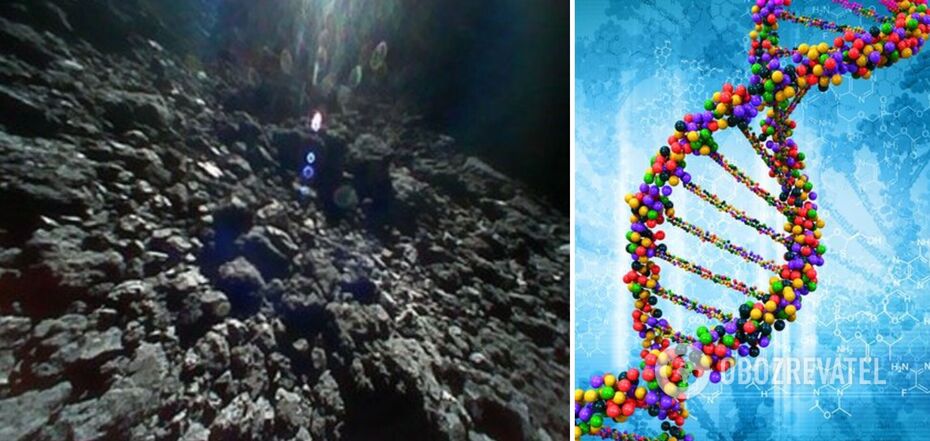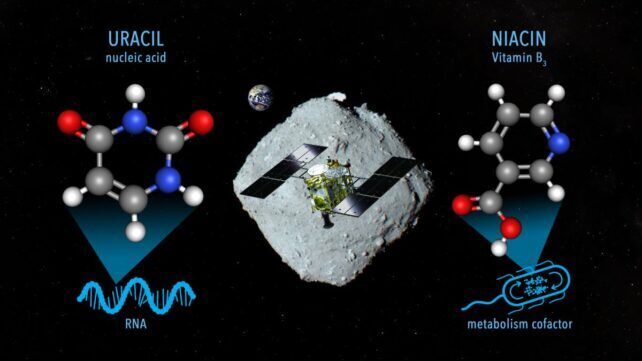Life
Possible solution to the mystery of the emergence of life on Earth discovered on a distant asteroid
For the first time in history, scientists have discovered key building blocks of RNA on an extraterrestrial object. Japanese researchers have discovered uracil, one of the five nucleic bases that make up the human genetic code, and niacin, a form of vitamin B3 responsible for metabolism, on the surface of the Ryugu asteroid. A number of other organic molecules were also discovered.
This is stated in a report published in the journal Nature Communications. This discovery may confirm the theory that the basis for the emergence of life on Earth was brought from outer space. It also suggests that life in its infancy may exist somewhere in the solar system.
"Since uracil and other nucleic bases are present in space, this means that the ingredients for nucleic acids (DNA and RNA) are present in this environment," said lead author Yasuhiro Oba, an astrochemist at Gokkaido University in Japan, according to Live Science.
Oba added that, in his opinion, "it is difficult to rule out the possibility that some life forms are present in the extraterrestrial environment."
The five nucleic bases - adenine, guanine, cytosine, thymine and uracil - combine with ribose and phosphate to form DNA and RNA, which make up the genetic code of all life on Earth. It is from RNA that proteins are formed that build and maintain cells and create more copies of DNA.
The discovery by Japanese scientists was made thanks to the Hayabusa2 spacecraft sent to obtain samples of the rock that makes up the asteroid Ryugu. It is believed that the asteroid comes from the same nebula that gave birth to the Sun and the planets of our system about 4.6 billion years ago.
Other building blocks for life, including 15 different amino acids, were also found in the samples sent back to Earth by Hayabusa2.
"The origin of life on Earth is a controversial issue, as various potential environments have been proposed, including oceanic hydrothermal vents and hot springs on land. However, there is no doubt that at some point in time, life needed amino acids to synthesise proteins responsible for a number of biological functions, such as catalysing metabolic reactions, replicating DNA, transporting molecules and shaping the structure of cells and organisms," the researchers said.
Although the Ryugu samples have hinted at solving the mystery of the emergence of life on Earth, they have raised another question: where exactly did these foundations for the emergence of life come from, either on Ryugu itself or in the nebula from which it originated. So far, scientists have no answer to this, but they have a theory.
Scientists speculate that amino acids and nucleotides may have been formed when the interstellar ice (which made up the asteroid) was pierced by intense cosmic rays. They probably broke down simple molecules, such as formaldehyde, ammonia, and hydrogen cyanide, and reconstituted them in more complex configurations. Subsequently, an asteroid like Ryugu could have brought these molecules to Earth, where they gave rise to life in the primordial oceans.
In addition to Ryugu, humanity is also studying the asteroid Bennu, which was sampled by NASA's OSIRIS-REx spacecraft in 2021. When these samples return to Earth in September 2023, scientists are likely to have new clues about the evolution of the solar system and its materials, as well as hints about how life originated from them.
Earlier, OBOZREVATEL also talked about scientists who put forward a new theory of the origin of life on Earth.
Subscribe to OBOZREVATEL's Telegram and Viber channels to keep up with the latest news.





























